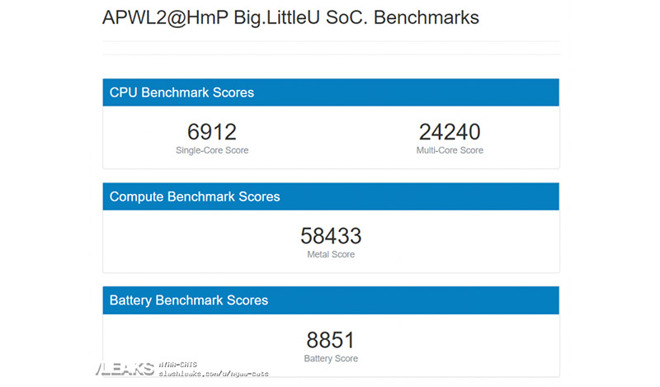Highly suspect benchmarks stoke rumors of Apple-designed ARM chips for Mac
An unsubstantiated, and highly suspect, "leak" on Friday claims to reveal benchmarks from a pair of desktop-class ARM processors supposedly designed by Apple, offering what could be the first look at A-series silicon destined for Mac.

Outlined in a post to Slashleaks on Friday are supposed Geekbench benchmarks for ARM big.LITTLE chips with 10- and 12-core architectures.
Information provided by an anonymous uploader claims the 10-core version is clocked at 3.4GHz, while supposed Geekbench screenshots show the 12-core chip, referenced as "APWL2@HmP," running at 3.19GHz. The two application processors achieved respective single-core scores of 7335 and 6912, and multi-core scores of 20580 and 24240.
What device the alleged ARM chips are powering is unknown, but the performance of each falls in line with desktop class hardware. Both processors beat single-core benchmarks set by Apple's 2017 27-inch Retina 5K iMac with 4.2GHz Intel Core i7-7700K, while the purported 12-core ARM chip's mutli-core score bests the 2018 15-inch MacBook Pro with 2.9GHz Intel Core i9-8950HK.
It is unclear if the benchmarks shared today are legitimate, but it should be noted that the uploader joined SlashleaksAppleInsider was unable to verify the leak and does not vouch for its veracity.
Apple has long been rumored to transition Mac away from Intel to a bespoke ARM architecture, but hard evidence of the development process has been elusive.
Last October, analyst Ming-Chi Kuo in a note to investors predicted an ARM-based mac to arrive in 2020 or 2021. More recently, Intel officials in February told Axios they expect the tech giant to make the switch "as soon as next year."

Outlined in a post to Slashleaks on Friday are supposed Geekbench benchmarks for ARM big.LITTLE chips with 10- and 12-core architectures.
Information provided by an anonymous uploader claims the 10-core version is clocked at 3.4GHz, while supposed Geekbench screenshots show the 12-core chip, referenced as "APWL2@HmP," running at 3.19GHz. The two application processors achieved respective single-core scores of 7335 and 6912, and multi-core scores of 20580 and 24240.
What device the alleged ARM chips are powering is unknown, but the performance of each falls in line with desktop class hardware. Both processors beat single-core benchmarks set by Apple's 2017 27-inch Retina 5K iMac with 4.2GHz Intel Core i7-7700K, while the purported 12-core ARM chip's mutli-core score bests the 2018 15-inch MacBook Pro with 2.9GHz Intel Core i9-8950HK.
It is unclear if the benchmarks shared today are legitimate, but it should be noted that the uploader joined SlashleaksAppleInsider was unable to verify the leak and does not vouch for its veracity.
Apple has long been rumored to transition Mac away from Intel to a bespoke ARM architecture, but hard evidence of the development process has been elusive.
Last October, analyst Ming-Chi Kuo in a note to investors predicted an ARM-based mac to arrive in 2020 or 2021. More recently, Intel officials in February told Axios they expect the tech giant to make the switch "as soon as next year."

Comments
Although I can dream these benchmarks are for a new Apple TV.
However, if this is true it’s going to set off a wave of unbridled rage not seen since Apple surprised everyone with a 64bit ARM processor.
The multicore scores don’t make sense if the single core scores are ~7000 GB4 points. So fake imo.
For the 10-core version to achieve something like this, it would be what, 2 big cores and 8 small cores? For the 12 core model, maybe 3 big cores and 9 small cores?
This would perhaps be fitting for a laptop. For desktop, no reason to spare the cores. Just have 6, 8, 12, 16, etc, especially if perf/watt is better than Intel Skylake.
unless Apple is doing something odd. Actually, why should there even be as many efficiency cores as performance cores, since notebooks aren’t as limited in power and heat as iPads are. Besides, with increased clock speed, even efficiency cores should have enough oomph so that not a lot would be needed, and I would imagine that increased performance would come from improved IP as well.